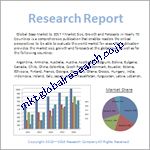目次
第1章.空間プロテオミクスの世界市場 エグゼクティブサマリー
1.1.空間プロテオミクスの世界市場規模・予測(2022~2032年)
1.2.地域別概要
1.3.セグメント別概要
1.3.1.製品別
1.3.2.技術別
1.3.3.ワークフロー別
1.3.4.サンプルタイプ別
1.3.5.最終用途別
1.4.主要動向
1.5.不況の影響
1.6.アナリストの提言と結論
第2章 空間プロテオミクスの世界市場世界の空間プロテオミクス市場の定義と調査前提条件
2.1.調査目的
2.2.市場の定義
2.3.調査の前提
2.3.1.包含と除外
2.3.2.限界
2.3.3.供給サイドの分析
2.3.3.1.入手可能性
2.3.3.2.インフラ
2.3.3.3.規制環境
2.3.3.4.市場競争
2.3.3.5.経済性(消費者の視点)
2.3.4.需要サイド分析
2.3.4.1.規制の枠組み
2.3.4.2.技術の進歩
2.3.4.3.環境への配慮
2.3.4.4.消費者の意識と受容
2.4.推定方法
2.5.調査対象年
2.6.通貨換算レート
第3章.空間プロテオミクスの世界市場ダイナミクス
3.1.市場促進要因
3.1.1.がん研究および創薬における空間プロテオミクスの採用拡大
3.1.2.イメージングおよびシーケンスプラットフォームの技術的進歩
3.1.3.個別化医療への需要の高まり
3.2.市場の課題
3.2.1.空間プロテオミクス技術に関連する高コスト
3.2.2.新興市場における認知度とアクセシビリティの低さ
3.3.市場機会
3.3.1.神経科学、免疫学、感染症における用途の拡大
3.3.2.アジア太平洋地域と中南米における空間プロテオミクスの拡大
第4章 空間プロテオミクス空間プロテオミクスの世界市場産業分析
4.1.ポーターのファイブフォース分析
4.1.1.サプライヤーの交渉力
4.1.2.バイヤーの交渉力
4.1.3.新規参入者の脅威
4.1.4.代替品の脅威
4.1.5.競合他社との競争
4.1.6.ポーターのファイブ・フォース・モデルへの未来的アプローチ
4.1.7.ポーターのファイブ・フォース影響度分析
4.2.PESTEL分析
4.2.1.政治的
4.2.2.経済
4.2.3.社会
4.2.4.技術
4.2.5.環境
4.2.6.法律
4.3.主な投資機会
4.4.トップ勝ち組戦略
4.5.破壊的トレンド
4.6.業界専門家の視点
4.7.アナリストの推奨と結論
第5章 空間プロテオミクスの世界市場空間プロテオミクスの世界市場規模・製品別予測(2022~2032年)
5.1.セグメントダッシュボード
5.2.機器
5.2.1.自動化
5.2.2.半自動および手動
5.3.消耗品
5.4.ソフトウェア
第6章 空間プロテオミクスの世界市場空間プロテオミクスの世界市場規模・技術別予測(2022~2032年)
6.1.セグメントダッシュボード
6.2.イメージングベース技術
6.3.質量分析ベースのテクノロジー
6.4.シーケンスベース技術
6.5.その他の技術
第7章 空間プロテオミクスの世界市場空間プロテオミクスのワークフロー別世界市場規模・予測(2022~2032年)
7.1.セグメントダッシュボード
7.2.サンプル前処理
7.3.機器分析
7.4.データ分析
第8章 空間プロテオミクスの世界市場空間プロテオミクスの世界市場サンプルタイプ別規模・予測(2022~2032年)
8.1.セグメントダッシュボード
8.2.FFPE
8.3.新鮮凍結
第9章 空間プロテオミクスの世界市場空間プロテオミクスの世界市場規模・用途別予測(2022~2032年)
9.1.セグメントダッシュボード
9.2.学術・トランスレーショナル研究機関
9.3.製薬・バイオテクノロジー企業
9.4.その他の最終用途
第10章 空間プロテオミクスの世界市場空間プロテオミクスの世界地域別市場規模・予測(2022~2032年)
10.1.北米
10.1.1.米国
10.1.2.カナダ
10.1.3.メキシコ
10.2.ヨーロッパ
10.2.1.イギリス
10.2.2.ドイツ
10.2.3.フランス
10.2.4.イタリア
10.2.5.スペイン
10.2.6.デンマーク
10.2.7.スウェーデン
10.2.8.ノルウェー
10.2.9.その他のヨーロッパ
10.3.アジア太平洋
10.3.1.中国
10.3.2.日本
10.3.3.インド
10.3.4.韓国
10.3.5.オーストラリア
10.3.6.タイ
10.3.7.その他のアジア太平洋地域
10.4.ラテンアメリカ
10.4.1.ブラジル
10.4.2.アルゼンチン
10.4.3.その他のラテンアメリカ
10.5.中東・アフリカ
10.5.1.サウジアラビア
10.5.2.アラブ首長国連邦
10.5.3.南アフリカ
10.5.4.クウェート
10.5.5.その他の中東・アフリカ
第11章.コンペティティブ・インテリジェンス
11.1.主要企業のSWOT分析
11.1.1.10Xジェノミクス
11.1.2.ブルカー
11.1.3.ナノストリング・テクノロジーズ
11.2.トップ市場戦略
11.3.企業プロフィール
11.3.1.10Xジェノミクス
11.3.2.ブルカー
11.3.3.ナノストリングテクノロジーズ
11.3.4.アコヤバイオサイエンス
11.3.5.パーキンエルマー
11.3.6.フルイディグム・コーポレーション
11.3.7.ダナハー
11.3.8.バイオテクネ
11.3.9.ルナフォア・テクノロジーズ
11.3.10.セブン・ブリッジズ・ジェノミクス社
第12章 研究プロセス研究プロセス
12.1.研究プロセス
12.1.1.データマイニング
12.1.2.分析
12.1.3.市場推定
12.1.4.バリデーション
12.1.5.出版
12.2.研究属性
表一覧
1.空間プロテオミクスの世界市場 地域別推計・予測(2022年~2032年)
2.空間プロテオミクスの世界市場 製品別推定・予測 (2022-2032)
3.空間プロテオミクスの世界市場:技術別推定・予測(2022-2032年)
4.北米の空間プロテオミクス市場:製品別(2022-2032年)
5.ヨーロッパ空間プロテオミクス市場:技術別(2022-2032年)
6.アジア太平洋地域空間プロテオミクス市場:ワークフロー別(2022-2032年)
7.主要企業トップと収益分析
図表一覧
1.空間プロテオミクスの世界市場規模(2022年・2032年)
2.地域別市場シェア分析(2024年
3.製品動向装置、消耗品、ソフトウェア
4.技術動向:技術動向:イメージングベース、シーケンスベース
5.ワークフロー分析:サンプル前処理と機器分析
6.エンドユーザー市場シェア分析
7.アジア太平洋市場成長予測
最終レポートには50以上の図表が含まれています。
Spatial proteomics, which enables the visualization and quantification of proteins within native tissue environments, is transforming biomedical research. Technologies such as Imaging Mass Cytometry (IMC), Multiplexed Ion Beam Imaging (MIBI), and next-generation sequencing (NGS) are at the forefront, facilitating high-resolution, spatially-resolved protein analysis. The adoption of spatial proteomics in cancer research has been particularly impactful, aiding the study of tumor microenvironments and advancing targeted therapies.
The growing need for data-driven precision medicine, coupled with increasing R&D investments by pharmaceutical and biotechnology companies, is a significant driver of market growth. Additionally, innovations such as Curio Bioscience’s Curio Seeker and NanoString’s GeoMx IO Proteome Atlas have strengthened the market by expanding capabilities for high-throughput protein mapping.
North America dominated the market in 2024, accounting for 49.13% of the global share, driven by advanced research infrastructure and significant funding. Asia-Pacific is expected to exhibit the fastest growth due to rising investments in healthcare, expanding research capabilities, and increasing adoption of spatial proteomics technologies in China, Japan, and India.
Major market players included in this report are:
• 10X Genomics
• Bruker
• NanoString Technologies, Inc.
• Akoya Biosciences, Inc.
• Fluidigm Corporation
• PerkinElmer
• Danaher
• Biotechne
• S2 Genomics, Inc.
• Seven Bridges Genomics Inc.
• Lunaphore Technologies
• Cayman Chemical
• Navinci Diagnostics
• Thermo Fisher Scientific
• Cytiva
The detailed segments and sub-segments of the market are explained below:
By Product:
• Instruments
o Automated
o Semi-Automated & Manual
• Consumables
• Software
By Technology:
• Imaging-Based Technologies
• Mass Spectrometry-Based Technologies
• Sequencing-Based Technologies
• Other Technologies
By Workflow:
• Sample Preparation
• Instrumental Analysis
• Data Analysis
By Sample Type:
• FFPE
• Fresh Frozen
By End-Use:
• Academic & Translational Research Institutes
• Pharmaceutical & Biotechnology Companies
• Other End-Use
By Region:
North America
• U.S.
• Canada
• Mexico
Europe
• UK
• Germany
• France
• Italy
• Spain
• Denmark
• Sweden
• Norway
Asia Pacific
• China
• Japan
• India
• South Korea
• Australia
• Thailand
Latin America
• Brazil
• Argentina
Middle East & Africa
• South Africa
• Saudi Arabia
• UAE
• Kuwait
Years considered for the study are as follows:
• Historical Year: 2022
• Base Year: 2023
• Forecast Period: 2024-2032
Key Takeaways
• Technology Trends: Imaging-based technologies accounted for the largest share, while sequencing-based technologies are expected to grow at the fastest CAGR.
• Key Applications: Cancer research and personalized medicine are driving market demand, particularly in drug discovery and biomarker identification.
• Regional Leadership: North America led the market in 2024 with 49.13% share, while Asia-Pacific is poised for the fastest growth over the forecast period.
• Major Players: Leading market players include 10X Genomics, Bruker, NanoString Technologies, Akoya Biosciences, and PerkinElmer.
❖ 免責事項 ❖
http://www.globalresearch.jp/disclaimer

